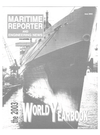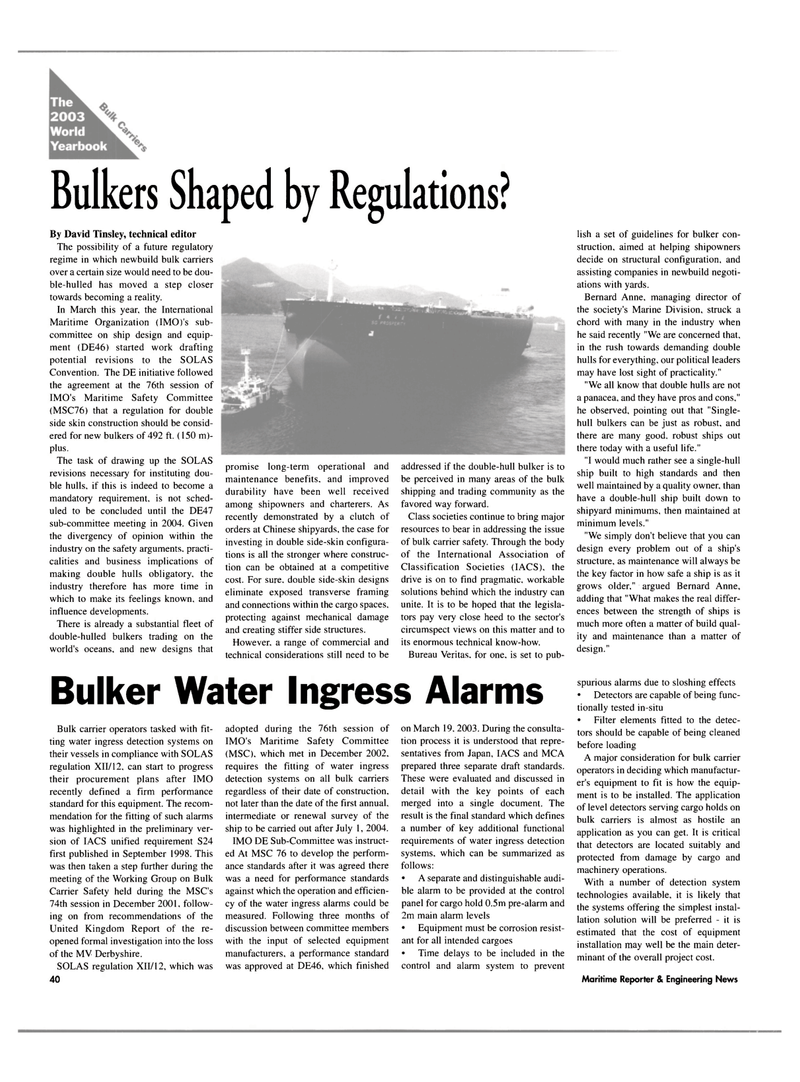
Page 40: of Maritime Reporter Magazine (June 2003)
Read this page in Pdf, Flash or Html5 edition of June 2003 Maritime Reporter Magazine
Bulkers Shaped by Regulations?
By David Tinsley, technical editor
The possibility of a future regulatory regime in which newbuild bulk carriers over a certain size would need to be dou- ble-hulled has moved a step closer towards becoming a reality.
In March this year, the International
Maritime Organization (IMO)'s sub- committee on ship design and equip- ment (DE46) started work drafting potential revisions to the SOLAS
Convention. The DE initiative followed the agreement at the 76th session of
IMO's Maritime Safety Committee (MSC76) that a regulation for double side skin construction should be consid- ered for new bulkers of 492 ft. (150 m)- plus.
The task of drawing up the SOLAS revisions necessary for instituting dou- ble hulls, if this is indeed to become a mandatory requirement, is not sched- uled to be concluded until the DE47 sub-committee meeting in 2004. Given the divergency of opinion within the industry on the safety arguments, practi- calities and business implications of making double hulls obligatory, the industry therefore has more time in which to make its feelings known, and influence developments.
There is already a substantial fleet of double-hulled bulkers trading on the world's oceans, and new designs that promise long-term operational and maintenance benefits, and improved durability have been well received among shipowners and charterers. As recently demonstrated by a clutch of orders at Chinese shipyards, the case for investing in double side-skin configura- tions is all the stronger where construc- tion can be obtained at a competitive cost. For sure, double side-skin designs eliminate exposed transverse framing and connections within the cargo spaces, protecting against mechanical damage and creating stiffer side structures.
However, a range of commercial and technical considerations still need to be addressed if the double-hull bulker is to be perceived in many areas of the bulk shipping and trading community as the favored way forward.
Class societies continue to bring major resources to bear in addressing the issue of bulk carrier safety. Through the body of the International Association of
Classification Societies (IACS). the drive is on to find pragmatic, workable solutions behind which the industry can unite. It is to be hoped that the legisla- tors pay very close heed to the sector's circumspect views on this matter and to its enormous technical know-how.
Bureau Veritas, for one, is set to pub-
Bulker Water Ingress Alarms
Bulk carrier operators tasked with fit- ting water ingress detection systems on their vessels in compliance with SOLAS regulation XII/12. can start to progress their procurement plans after IMO recently defined a firm performance standard for this equipment. The recom- mendation for the fitting of such alarms was highlighted in the preliminary ver- sion of IACS unified requirement S24 first published in September 1998. This was then taken a step further during the meeting of the Working Group on Bulk
Carrier Safety held during the MSC's 74th session in December 2001, follow- ing on from recommendations of the
United Kingdom Report of the re- opened formal investigation into the loss of the MV Derbyshire.
SOLAS regulation XII/12, which was 40 adopted during the 76th session of
IMO's Maritime Safety Committee (MSC). which met in December 2002. requires the fitting of water ingress detection systems on all bulk carriers regardless of their date of construction, not later than the date of the first annual, intermediate or renewal survey of the ship to be carried out after July 1, 2004.
IMO DE Sub-Committee was instruct- ed At MSC 76 to develop the perform- ance standards after it was agreed there was a need for performance standards against which the operation and efficien- cy of the water ingress alarms could be measured. Following three months of discussion between committee members with the input of selected equipment manufacturers, a performance standard was approved at DE46, which finished on March 19. 2003. During the consulta- tion process it is understood that repre- sentatives from Japan, IACS and MCA prepared three separate draft standards.
These were evaluated and discussed in detail with the key points of each merged into a single document. The result is the final standard which defines a number of key additional functional requirements of water ingress detection systems, which can be summarized as follows: • A separate and distinguishable audi- ble alarm to be provided at the control panel for cargo hold 0.5m pre-alarm and 2m main alarm levels • Equipment must be corrosion resist- ant for all intended cargoes • Time delays to be included in the control and alarm system to prevent lish a set of guidelines for bulker con- struction, aimed at helping shipowners decide on structural configuration, and assisting companies in newbuild negoti- ations with yards.
Bernard Anne, managing director of the society's Marine Division, struck a chord with many in the industry when he said recently "We are concerned that, in the rush towards demanding double hulls for everything, our political leaders may have lost sight of practicality." "We all know that double hulls are not a panacea, and they have pros and cons," he observed, pointing out that "Single- hull bulkers can be just as robust, and there are many good, robust ships out there today with a useful life." "I would much rather see a single-hull ship built to high standards and then well maintained by a quality owner, than have a double-hull ship built down to shipyard minimums, then maintained at minimum levels." "We simply don't believe that you can design every problem out of a ship's structure, as maintenance will always be the key factor in how safe a ship is as it grows older." argued Bernard Anne, adding that "What makes the real differ- ences between the strength of ships is much more often a matter of build qual- ity and maintenance than a matter of design." spurious alarms due to sloshing effects • Detectors are capable of being func- tionally tested in-situ • Filter elements fitted to the detec- tors should be capable of being cleaned before loading
A major consideration for bulk carrier operators in deciding which manufactur- er's equipment to fit is how the equip- ment is to be installed. The application of level detectors serving cargo holds on bulk carriers is almost as hostile an application as you can get. It is critical that detectors are located suitably and protected from damage by cargo and machinery operations.
With a number of detection system technologies available, it is likely that the systems offering the simplest instal- lation solution will be preferred - it is estimated that the cost of equipment installation may well be the main deter- minant of the overall project cost. 42 Maritime Reporter & Engineering News

 39
39

 41
41
